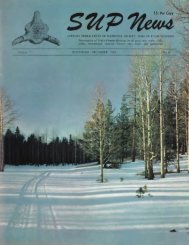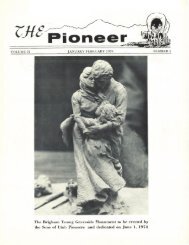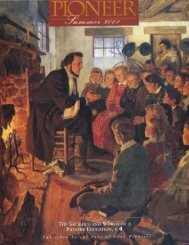Pioneer: 2011 Vol.58 No.3
Create successful ePaper yourself
Turn your PDF publications into a flip-book with our unique Google optimized e-Paper software.
Eagle Gate, which<br />
is at State Street and South Temple,<br />
has changed many times during its<br />
146 [now 152] years of existence.<br />
As the entrance to Brigham<br />
Young’s estate at the mouth of City<br />
Creek Canyon, it is located near<br />
where the pioneers homesteaded<br />
that first summer in 1847.<br />
Consistent with his New<br />
England heritage, President Young<br />
fenced and gated the land for<br />
privacy and also for protection from<br />
City Creek flooding. It was designed<br />
by architect Truman O. Angell and<br />
Hiram B. Clawson.<br />
The original eagle was carved<br />
by Ralph Ramsey and William<br />
Spring from five laminated wooden<br />
blocks and used an actual eagle<br />
that had been found in City Creek<br />
Canyon as its model. The monument<br />
weighed 500 pounds, had<br />
16-foot-wide outstretched wings<br />
and rested upon curved wooden<br />
arches that used 9-foot-high<br />
cobblestone bases as their anchor.<br />
The eagle sat on a beehive and a<br />
star mount.<br />
Large wooden gates closed<br />
the 22-foot-wide opening of the<br />
original Eagle Gate at night. Young<br />
had the Beehive House, Lion<br />
House, private offices, a<br />
flower garden, school, barns,<br />
sheds, greeneries, orchards<br />
and vegetable gardens in<br />
his yard. For many years, the gate<br />
not only marked the entrance to<br />
Young’s property but also to City<br />
Creek Canyon, as the highway was<br />
then the canyon toll road, not State<br />
Street.<br />
Fourteen years after Young’s<br />
death in 1891, the gates were removed<br />
and the street was widened<br />
to two lanes. Soon after, electric<br />
streetcars began traveling the area<br />
and a greater height was needed to<br />
accommodate the overhead wires.<br />
The eagle was then sent back East<br />
to be covered with a layer of copper,<br />
and new supports resting on<br />
stone pillars were added. The gate<br />
was also widened in a new design<br />
by architect J. Don Carlos Young.<br />
It was remodeled another three<br />
times during the next 60<br />
years and eventually became<br />
just wide enough for<br />
four lanes of traffic, but<br />
there was no extra room.<br />
17 <br />
On April 18, 1960, a truck<br />
severely damaged Eagle Gate. The<br />
eagle and beehive were removed<br />
later that day. The Church of Jesus<br />
Christ of Latter-day Saints, which<br />
owned them, eventually gave the<br />
eagle and beehive to the Daughters<br />
of Utah <strong>Pioneer</strong>s because the<br />
wooden portions had deteriorated<br />
and could not be remounted again.<br />
They are in the DUP museum<br />
today at 300 N. Main.<br />
In succeeding weeks all the<br />
gate structure was removed. A time<br />
capsule dating to 1891 was found<br />
in one of the bases of the old support<br />
columns. For more than three<br />
years, there was no Eagle Gate at<br />
State Street and South Temple.<br />
Architect George Cannon Young,<br />
a descendant of Brigham<br />
Young, began to design a new<br />
frame to support a new Eagle Gate.<br />
Artist Grant R. Fairbanks made<br />
a replica of the original bird out<br />
of bronze, though this one was<br />
larger, with a 20-foot wingspan and<br />
10-foot-long body, and weighed<br />
about 4,000 pounds. The stone<br />
fence near the Lion House was<br />
moved 20 feet west to make room<br />
for a larger five-lane span.<br />
—Deseret News, Friday, Nov. 24,<br />
2006







